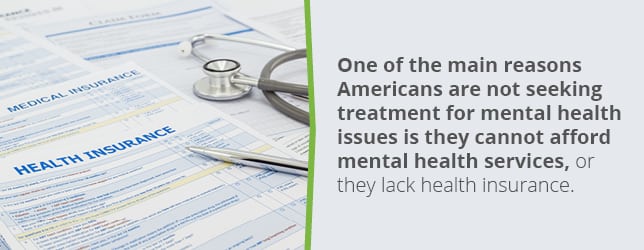Biggest Challenges Facing Clinical Psychologists in 2018
Those who have chosen a career in psychology made a smart choice. According to the Bureau of Labor Statistics, employment of psychologists is projected to grow 14 percent, or faster than average, from 2016 to 2026. The median yearly wage for psychologists in 2017 was $77,030.
However, despite the rewards of a psychology career, clinical psychologists face many challenges that do not come with the job description. Psychologists are not only expected to observe clients and teach them new thinking patterns and behaviors, but they also need to be highly adaptable and willing to tailor their services to meet the unique needs of clients. A lot is changing every day with the healthcare system and the types of people who need treatment the most.
For example, although there may be a greater concentration of mental health professionals in urban or suburban areas, rural communities are experiencing a severe shortage of behavioral health treatment centers. Although competition might be high in a prosperous community, there are not enough psychologists to meet the needs of poorer populations.
Across all communities, people are not seeking the treatment they need. Forty-three million Americans have a mental health condition according to the State of Mental Health Report released by Mental Health America (MHA) in 2018. However, 57 percent of American adults have not received mental health treatment. Psychologists face the challenge of reaching clients who need help and retaining clientele long enough for treatment to be effective.
Many Americans are not seeking treatment for various reasons, such as not having health coverage. Many are not willing to pay for mental health care or have the funds to pay out of pocket. Therefore, the current healthcare system has added another layer of challenges for the mental health care industry.
How can psychologists overcome the issues they face every day while helping clients improve their mental health? How can mental health professionals earn fair compensation for their knowledge, education and high levels of responsibility despite healthcare costs? In this post, we’ll explore some of the greatest challenges clinical psychologists must cope with in today’s world, behavioral health industry trends and possible solutions to common issues.
Common Issues Facing Behavioral Health Practices
Every career poses its own set of obstacles. Most behavioral health professionals know what to expect when they choose a career in psychology. However, that does not make the job any less frustrating or intimidating at times. The following issues are common in today’s behavioral health workforce, and you may recognize some of the issues in your practice.
1. Financing
One of the main reasons Americans are not seeking treatment for mental health issues is they cannot afford mental health services, or they lack health insurance. As of today, a lot of confusion and uncertainty surrounds the federal health care policy. If states lose funding for Medicaid and Medicare, millions of Americans will feel the effect. For example, according to a 2018 report, 67,562,271 individuals were enrolled in Medicaid. If a person cannot afford to visit the doctor for the common cold, it is highly unlikely they will invest in regular therapy sessions.
Clinical psychologists are feeling the impact of an inconsistent and confusing healthcare system. According to the State of Mental Health Report, 14.7 percent of adults with mental illness remain uninsured. One out of five adults with mental illness reported not being able to get the treatment they needed for the following reasons:
- Lack of adequate insurance
- Lack of available providers
- Lack of available treatment options
- Lack of funds to cover expenses such as copays or uncovered treatment
The funding issue is severe for young people as well. Sixty-three percent of youth with major depression do not receive any treatment. Without patients willing to pay for treatment, psychologists face the challenge of reaching those in need while receiving fair compensation.
What does the future for healthcare look like? The current administration’s priorities as reflected in the 2019 budget are as follows:
- Plans for spending over $10 billion over five years to fight the opioid epidemic and serious mental illness
- Plans to reduce Medicaid by $1.4 trillion and Medicare by about $500 billion
- Plans to include $15 million for new Assertive Community Treatment for individuals with serious mental illness
The budget includes important funding but also substantially reduces funding for two of the largest payers of behavioral health treatment in the country — Medicaid and Medicare. It is difficult to predict what the future holds for healthcare professionals and Americans in need of treatment.
The current administration also ended cost-sharing reductions (CSRs), or discounts on deductibles and copayments to payers selling individual health plans, and premiums are expected to grow 20 percent for individual health plans. Also, there is no longer a penalty for being uninsured as there was with the Affordable Care Act (ACA), also known as Obamacare. The uninsured rate has increased an estimated 3.2 million Americans from 2016 to 2017, according to a Gallup poll.
2. Retaining Workers
Behavioral health practices are not only struggling to keep clients, but they also have to fight to keep their workers. Salaries for behavioral health workers are lower than other positions in healthcare or business, leading to a shortage of psychologists in areas where they are most needed. Many behavioral health professionals leave the profession altogether, while other Ph.D.s are not even considering entering the behavioral health field because of lower compensation.
The Annapolis Coalition on the Behavioral Health Workforce developed a plan to combat the following common issues seen in America’s behavioral health workforce:
- Trouble finding or recruiting interested or qualified employees
- Difficulty retaining workers
- An aging workforce
- A shortage of providers who are qualified to serve children and the elderly
- Lack of behavioral health providers in rural communities
- Lack of training in management and leadership for the next generation of leaders
Since the development of the plan, the Annapolis Coalition has helped strengthen the workforce by implementing recruitment and retainment strategies, increasing relevant training and promoting the development of leadership skills.
Nevertheless, behavioral health professionals are more concentrated in urban and suburban areas, and a shortage remains in rural areas. For example, there is a shortage of 2,800 psychiatrists in rural and underserved areas according to a 2015 report by the American Hospital Association (AHA).
2. Keeping Clients Engaged
In 2018, every business, including healthcare practices, needs to interact with their clients in a way that keeps them engaged and makes them feel comfortable. In areas where there are plenty of treatment options, clients will not hesitate to shop around and find a psychologist who meets their needs. To beat the competition, psychologists have to keep up with the times.
Clients want and expect easy communication, access to appointment reminders, an overall pleasant experience and high-quality care. For clients to be loyal, psychologists have to meet all of their client’s demands. Some psychologists may feel the pressure of having an online presence that makes an impact while also providing the best care possible.
3. Reducing Stigma
A lot of Americans resist seeking treatment because of the stigma attached to mental illness. The myth that the mentally ill are violent persists, especially because many people blame mass shootings on mental illnesses. The fact is, mass shooting by people with serious mental illness accounts for less than one percent of all yearly gun-related homicides. Overall, only about three percent of violent crime can be traced to individuals with severe mental illness.
According to a 2017 survey conducted by One Medical and Ipsos, 69 percent of Americans claim at least one mental health issue affects their well-being. However, 29 percent say they feel embarrassed to talk about their mental health, even with professionals.
Psychologists face the challenge of gaining new clients and retaining clients when a stigma exists and continues to thrive.
How to Move Forward
Despite the weight of the challenges modern-day psychologists face, there is hope. By being flexible and having an open mind, behavioral health workers can adapt to meet clients’ needs. Consider the following ways to overcome common issues in a behavioral health workplace.
1. Offer Peer Support
If you need assistance connecting with clients and making them feel comfortable, consider using peer support services. Peer support is highly effective and cost-effective, especially with addiction treatment. Peer support also helps clients feel more at ease and trusting of the treatment center. Usually, trained peer support specialists are in recovery or have mental health disorders and can connect with clients on a deep level of understanding.
2. Consider Integrated Behavioral-Physical Health Care
A growing trend in the behavioral health industry is combining behavioral health care with physical health care to create a fully comprehensive health service. This type of care addresses stress-related physical symptoms and behaviors that contribute to chronic illness in addition to mental health issues and substance abuse. At a behavioral and physical healthcare practice, clients can enjoy the convenience and benefits of a complete package.
Psychologists are training in primary care through internships and postdoctoral training. Psychologists should also consider the importance of practicing in community health centers. Low-income communities are in great need of comprehensive care.
3. Find Financial Support
It can be tough compensating workers for their levels of education and responsibility when many clients are struggling to pay their medical bills. How is it possible to keep a practice running smoothly with so many financial concerns? Fortunately, there may be assistance available to help support the financial structure of your practice. Here are a few examples:
A. The DIAMOND Program
The Depression Improvement Across Minnesota, Offering a New Direction (DIAMOND) Program was developed in Minnesota in 2008 as a bundled payment model to support chronic care management for depression treatment. The program collaborated with commercial health plans, the Minnesota Department of Human Services and other medical providers in the state giving primary care providers a monthly bundled payment from six major insurance companies for every patient needing depression care.
B. SAMHSA-HRSA Center for Integrated Health Solutions
The Substance Abuse and Mental Health Services Administration (SAMHSA) and the Health Resources and Services Administration (HRSA) is creating a financial structure to help support education and practice within integrated behavioral health primary care practices. From 2014 to 2018, more than 700 awards for behavioral health integration and substance abuse programs will be given, with a maximum of $250,000 per award.
A lot of individuals do not get treatment simply because it is unaffordable. Consider researching local programs to find ways you can make your services more affordable without sacrificing the knowledge and passion of a competent health care team.
4. Build a Stronger Workforce
A strong workforce is critical to your practice’s success. Here are strategies for building a solid workforce you can depend on:
- Assess your workforce: First, evaluate your current workforce and clientele. Look for strengths and areas that need improvement.
- Consider the community: Make sure your workforce is knowledgeable about the challenges facing your community. Make sure they can engage with clients effectively.
- Train your workforce: Train your workforce in behavioral health screening techniques, like suicide risk screening. Teach workers to consider mental health trends like increased anxiety due to mobile device use or the opioid crisis.
- Establish an assessment procedure: Offer assessment, treatment and referrals, so all behavioral health care needs are met on-site.
- Utilize interprofessional education: Use available education and training to begin integrating primary and behavioral healthcare, so employees are prepared to offer comprehensive services.
- Form partnerships: Contact higher education programs to build partnerships that address the need of the community and help you recruit behavioral health professionals.
5. Step out of the Comfort Zone
For the greatest number of opportunities, consider working in a setting with shared electronic health records and other healthcare professionals. You may need to adapt to a changing healthcare environment by integrating with the rest of the healthcare system.
6. Serve Underserved Populations
If you have too much free time in your schedule, consider offering your services to rural communities, inner cities, children, the elderly population or substances abuse programs either through telehealth services, part-time consultation or full-time employment. Telehealth allows you to provide patient care virtually, through live video, for example.
Children and the elderly especially need attention. Too often there is not enough funding or treatment for all the children who need it. Children are likely to carry mental health issues into adulthood without adequate treatment.
Likewise, the growing elderly population is in need of behavioral health care. According to the U.S. Census Bureau’s 2017 National Population Projections, 1 in every 5 residents will be retirement age by 2030.
7. Encourage Community Engagement
Psychologists, students and other behavioral health professionals should spend time in the community and participate in committee meetings. Behavioral health professionals can develop relationships with decision-makers and influence policymaking. Encourage students and those new in the field to embrace leadership roles and become advocates for mental health.
8. Fight Stigma
All behavioral health workers can help reduce stigma by getting the treatment and encouraging open discussion of mental health issues. Stigmas exist in the workplace just as much in the general public. To ensure your workforce is strong and healthy, encourage behavioral health professionals to practice self-care. Promote knowledge, growth and compassion regarding mental health problems wherever you are and always be mindful of language.
9. Improve Client Communication
Practices both big and small need to engage with clients online and through mobile platforms to keep up with the competition and make clients feel appreciated. Many practices send appointment alerts through text messages, for example, and you do not want to fall behind.
Online communication is not just for younger patients. Clients of all ages want to feel like they are truly cared for. If you treat them like a good friend, they will be more apt to trust you and the care you provide. They will also be more open to sharing their experiences, thoughts and feelings which would lead to more effective treatment. Also, clients know they have plenty of other options if they are unsatisfied with their current health care provider. Make it a priority to make clients feel comfortable and appreciated.
How Behavioral Health EHR Software Can Help
Life as a psychologist or behavioral health professional is becoming increasingly tricky in 2018 with changes to healthcare, lack of funding, new technology and the need to integrate with other healthcare systems. Also, psychologists feel pressured to tailor their services to meet client demands. It’s understandable if behavioral health professionals feel overwhelmed by current healthcare trends, but fortunately, there are helpful tools available to help relieve some of the workplace tension.
ICANotes is behavioral health EHR software designed to improve workflow in integrated settings, make billing easy and fast, and keep client information organized and accessible. With ICANotes your practice can enjoy comprehensive documentation that takes the stress and time out of paperwork and note-taking. Your clients will also appreciate the appointment reminder services ICANotes offers.
Behavioral health practices are treating more conditions than ever before. ICANotes promotes team efficiency and makes sure all workers are on the same page, so you can provide the best patient care possible and have a moment to catch your breath. Contact ICANotes today for more information, watch our live demo or request a free trial to get started.
Related Posts:
Are Mental Health Record Guidelines the Same for Every State?
How Electronic Health Records Are Improving Patient Care
2018 Updates to the EHR Incentive Program
How to Give Patients Access to Their Mental Health Records





